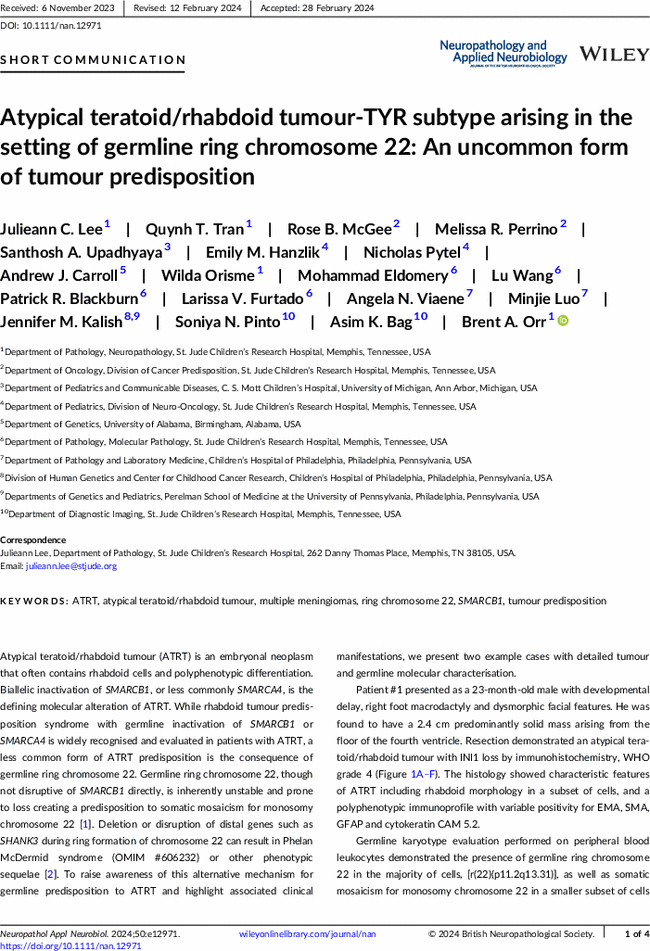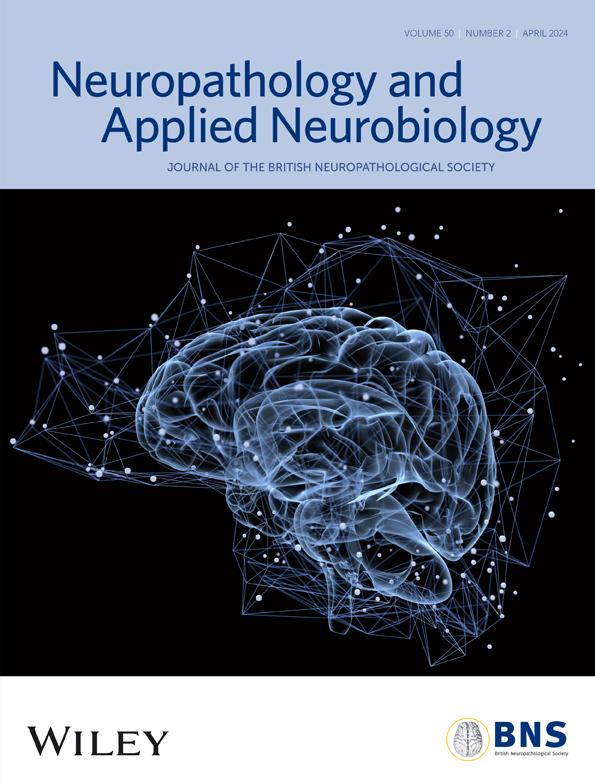Atypical teratoid/rhabdoid tumour-TYR subtype arising in the setting of germline ring chromosome 22: An uncommon form of tumour predisposition
Corresponding Author
Julieann C. Lee
Department of Pathology, Neuropathology, St. Jude Children's Research Hospital, Memphis, Tennessee, USA
Correspondence
Julieann Lee, Department of Pathology, St. Jude Children's Research Hospital, 262 Danny Thomas Place, Memphis, TN 38105, USA.
Email: [email protected]
Search for more papers by this authorQuynh T. Tran
Department of Pathology, Neuropathology, St. Jude Children's Research Hospital, Memphis, Tennessee, USA
Search for more papers by this authorRose B. McGee
Department of Oncology, Division of Cancer Predisposition, St. Jude Children's Research Hospital, Memphis, Tennessee, USA
Search for more papers by this authorMelissa R. Perrino
Department of Oncology, Division of Cancer Predisposition, St. Jude Children's Research Hospital, Memphis, Tennessee, USA
Search for more papers by this authorSanthosh A. Upadhyaya
Department of Pediatrics and Communicable Diseases, C. S. Mott Children's Hospital, University of Michigan, Ann Arbor, Michigan, USA
Search for more papers by this authorEmily M. Hanzlik
Department of Pediatrics, Division of Neuro-Oncology, St. Jude Children's Research Hospital, Memphis, Tennessee, USA
Search for more papers by this authorNicholas Pytel
Department of Pediatrics, Division of Neuro-Oncology, St. Jude Children's Research Hospital, Memphis, Tennessee, USA
Search for more papers by this authorAndrew J. Carroll
Department of Genetics, University of Alabama, Birmingham, Alabama, USA
Search for more papers by this authorWilda Orisme
Department of Pathology, Neuropathology, St. Jude Children's Research Hospital, Memphis, Tennessee, USA
Search for more papers by this authorMohammad Eldomery
Department of Pathology, Molecular Pathology, St. Jude Children's Research Hospital, Memphis, Tennessee, USA
Search for more papers by this authorLu Wang
Department of Pathology, Molecular Pathology, St. Jude Children's Research Hospital, Memphis, Tennessee, USA
Search for more papers by this authorPatrick R. Blackburn
Department of Pathology, Molecular Pathology, St. Jude Children's Research Hospital, Memphis, Tennessee, USA
Search for more papers by this authorLarissa V. Furtado
Department of Pathology, Molecular Pathology, St. Jude Children's Research Hospital, Memphis, Tennessee, USA
Search for more papers by this authorAngela N. Viaene
Department of Pathology and Laboratory Medicine, Children's Hospital of Philadelphia, Philadelphia, Pennsylvania, USA
Search for more papers by this authorMinjie Luo
Department of Pathology and Laboratory Medicine, Children's Hospital of Philadelphia, Philadelphia, Pennsylvania, USA
Search for more papers by this authorJennifer M. Kalish
Division of Human Genetics and Center for Childhood Cancer Research, Children's Hospital of Philadelphia, Philadelphia, Pennsylvania, USA
Departments of Genetics and Pediatrics, Perelman School of Medicine at the University of Pennsylvania, Philadelphia, Pennsylvania, USA
Search for more papers by this authorSoniya N. Pinto
Department of Diagnostic Imaging, St. Jude Children's Research Hospital, Memphis, Tennessee, USA
Search for more papers by this authorAsim K. Bag
Department of Diagnostic Imaging, St. Jude Children's Research Hospital, Memphis, Tennessee, USA
Search for more papers by this authorBrent A. Orr
Department of Pathology, Neuropathology, St. Jude Children's Research Hospital, Memphis, Tennessee, USA
Search for more papers by this authorCorresponding Author
Julieann C. Lee
Department of Pathology, Neuropathology, St. Jude Children's Research Hospital, Memphis, Tennessee, USA
Correspondence
Julieann Lee, Department of Pathology, St. Jude Children's Research Hospital, 262 Danny Thomas Place, Memphis, TN 38105, USA.
Email: [email protected]
Search for more papers by this authorQuynh T. Tran
Department of Pathology, Neuropathology, St. Jude Children's Research Hospital, Memphis, Tennessee, USA
Search for more papers by this authorRose B. McGee
Department of Oncology, Division of Cancer Predisposition, St. Jude Children's Research Hospital, Memphis, Tennessee, USA
Search for more papers by this authorMelissa R. Perrino
Department of Oncology, Division of Cancer Predisposition, St. Jude Children's Research Hospital, Memphis, Tennessee, USA
Search for more papers by this authorSanthosh A. Upadhyaya
Department of Pediatrics and Communicable Diseases, C. S. Mott Children's Hospital, University of Michigan, Ann Arbor, Michigan, USA
Search for more papers by this authorEmily M. Hanzlik
Department of Pediatrics, Division of Neuro-Oncology, St. Jude Children's Research Hospital, Memphis, Tennessee, USA
Search for more papers by this authorNicholas Pytel
Department of Pediatrics, Division of Neuro-Oncology, St. Jude Children's Research Hospital, Memphis, Tennessee, USA
Search for more papers by this authorAndrew J. Carroll
Department of Genetics, University of Alabama, Birmingham, Alabama, USA
Search for more papers by this authorWilda Orisme
Department of Pathology, Neuropathology, St. Jude Children's Research Hospital, Memphis, Tennessee, USA
Search for more papers by this authorMohammad Eldomery
Department of Pathology, Molecular Pathology, St. Jude Children's Research Hospital, Memphis, Tennessee, USA
Search for more papers by this authorLu Wang
Department of Pathology, Molecular Pathology, St. Jude Children's Research Hospital, Memphis, Tennessee, USA
Search for more papers by this authorPatrick R. Blackburn
Department of Pathology, Molecular Pathology, St. Jude Children's Research Hospital, Memphis, Tennessee, USA
Search for more papers by this authorLarissa V. Furtado
Department of Pathology, Molecular Pathology, St. Jude Children's Research Hospital, Memphis, Tennessee, USA
Search for more papers by this authorAngela N. Viaene
Department of Pathology and Laboratory Medicine, Children's Hospital of Philadelphia, Philadelphia, Pennsylvania, USA
Search for more papers by this authorMinjie Luo
Department of Pathology and Laboratory Medicine, Children's Hospital of Philadelphia, Philadelphia, Pennsylvania, USA
Search for more papers by this authorJennifer M. Kalish
Division of Human Genetics and Center for Childhood Cancer Research, Children's Hospital of Philadelphia, Philadelphia, Pennsylvania, USA
Departments of Genetics and Pediatrics, Perelman School of Medicine at the University of Pennsylvania, Philadelphia, Pennsylvania, USA
Search for more papers by this authorSoniya N. Pinto
Department of Diagnostic Imaging, St. Jude Children's Research Hospital, Memphis, Tennessee, USA
Search for more papers by this authorAsim K. Bag
Department of Diagnostic Imaging, St. Jude Children's Research Hospital, Memphis, Tennessee, USA
Search for more papers by this authorBrent A. Orr
Department of Pathology, Neuropathology, St. Jude Children's Research Hospital, Memphis, Tennessee, USA
Search for more papers by this author
CONFLICT OF INTEREST STATEMENT
The authors declare they have no conflict of interest related to this study.
Open Research
DATA AVAILABILITY STATEMENT
Supporting data available from the corresponding author upon reasonable request.
Supporting Information
| Filename | Description |
|---|---|
| nan12971-sup-0001-FigureS1.pdfPDF document, 18.6 MB | Figure S1. A. Patient #2: Multiple meningiomas by MR imaging. B. Patient #2: Histologic images of the patient's ATRT. |
| nan12971-sup-0002-TableS1.xlsxExcel 2007 spreadsheet , 12.4 KB | Table S1. Review of patients with ATRT and germline r(22). |
| nan12971-sup-0003-TableS2.xlsxExcel 2007 spreadsheet , 10.5 KB | Table S2. Genes included in Comprehensive Solid Tumour Panel. |
Please note: The publisher is not responsible for the content or functionality of any supporting information supplied by the authors. Any queries (other than missing content) should be directed to the corresponding author for the article.
REFERENCES
- 1Byers HM, Adam MP, LaCroix A, et al. Description of a new oncogenic mechanism for atypical teratoid rhabdoid tumors in patients with ring chromosome 22. Am J Med Genetics A. 2017; 173(1): 245-249. PMID:27734605. doi:10.1002/ajmg.a.37993
- 2Jeffries AR, Curran S, Elmslie F, et al. Molecular and phenotypic characterization of ring chromosome 22. Am J Med Genet A. 2005; 137(2): 139-147. PMID: 16059935.
- 3Johann PD, Erkek S, Zapatka M, et al. Atypical teratoid/rhabdoid tumors are comprised of three epigenetic subgroups with distinct enhancer landscapes. Cancer Cell. 2016; 29(3): 379-393. PMID: 26923874. doi:10.1016/j.ccell.2016.02.001
- 4Upadhyaya SA, Robinson GW, Onar-Thomas A, et al. Relevance of molecular groups in children with newly diagnosed atypical teratoid rhabdoid tumor: results from prospective St. Jude multi-institutional. Trials Clin Cancer Res. 2021; 27(10): 2879-2889. PMID: 33737307. doi:10.1158/1078-0432.CCR-20-4731
- 5Phelan K, Rogers RC, Boccuto L. Phelan-McDermid Syndrome. 2005 May 11 [updated 2018 Jun 7]. In: MP Adam, DB Everman, GM Mirzaa, RA Pagon, SE Wallace, LJH Bean, KW Gripp, A Amemiya, eds. GeneReviews® [Internet]. University of Washington, Seattle; 1993–2022. PMID: 20301377.
- 6Cho EH, Park JB, Kim JK. Atypical teratoid rhabdoid brain tumor in an infant with ring chromosome 22. Korean J Pediatr. 2014; 57(7): 333-336. PMID: 25114695. doi:10.3345/kjp.2014.57.7.333
- 7Crocco M, Panciroli M, Milanaccio C, et al. Case report: the emerging role of ring chromosome 22 in Phelan-McDermid syndrome with atypical teratoid/rhabdoid tumor: the first child treated with growth hormone. Front Neurol. 2021; 29(12):741062. PMID: 34777208.
10.3389/fneur.2021.741062 Google Scholar
- 8Rubio A. March 1997--4 year old girl with ring chromosome 22 and brain tumor. Brain Pathol. 1997; 7(3): 1027-1028. PMID: 9217983. doi:10.1111/j.1750-3639.1997.tb00902.x
- 9Yamashita H, Arakawa Y, Terada Y, et al. Whole-genome sequencing analysis of an atypical teratoid/rhabdoid tumor in a patient with Phelan-McDermid syndrome: a case report and systematic review. Brain Tumor Pathol 2022 Oct; 39(4): 232–239. PMID: 35750988. doi:10.1007/s10014-022-00440-7.
- 10Korones DN, Meyers SP, Rubio A, Torres C, Constine LS. A 4-year-old girl with a ventriculoperitoneal shunt metastasis of a central nervous system atypical teratoid/rhabdoid tumor. Med Pediatr Oncol. 1999;(5): 389-391.
- 11Kotch C, Fisher MJ, Lin F, et al. Atypical teratoid rhabdoid tumor in a child with neurofibromatosis type 2: a novel dual diagnosis. Cancer Genet. 2022; 262-263: 1-4. PMID: 34972035. doi:10.1016/j.cancergen.2021.12.004
- 12Arinami T, Kondo I, Hamaguchi H, Nakajima S. Multifocal meningiomas in a patient with a constitutional ring chromosome 22. J Med Genet. 1986; 23(2): 178-180. PMID: 3712397. doi:10.1136/jmg.23.2.178
- 13Koza SA, Tabet AC, Bonaglia MC, et al. Consensus recommendations on counselling in Phelan-McDermid syndrome, with special attention to recurrence risk and to ring chromosome 22. Eur J Med Genet. 2023; 66(7):104773. doi:10.1016/j.ejmg.2023.104773
- 14Petrella R, Levine S, Wilmot PL, Ashar KD, Casamassima AC, Shapiro LR. Multiple meningiomas in a patient with constitutional ring chromosome 22. Am J Med Genet. 1993; 47(2): 184-186. PMID: 8213904. doi:10.1002/ajmg.1320470211
- 15Ziats CA, Jain L, McLarney B, et al. Neurofibromatosis type 2 in Phelan-McDermid syndrome: institutional experience and review of the literature. Eur J Med Genet. 2020; 63(11):104042. PMID: 32822873. doi:10.1016/j.ejmg.2020.104042
- 16Wenger SL, Boone LY, Cummins JH, et al. Newborn infant with inherited ring and de novo interstitial deletion on homologous chromosome 22s. Am J Med Genet. 2000; 91(5): 351-354.
10.1002/(SICI)1096-8628(20000424)91:5<351::AID-AJMG6>3.0.CO;2-A CAS PubMed Web of Science® Google Scholar




